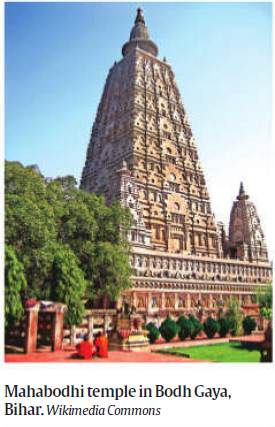Mahabodhi Temple Dispute: Buddhist Protests Renew Demand for Full Control
(Source – Indian Express, Section – Explained, Page – 14)
| Topic: GS1 – History |
| Context |
|
Analysis of the news:

Historical and Religious Significance of the Temple
- The Mahabodhi Temple in Bodh Gaya, Bihar, marks the site where Prince Siddhartha attained enlightenment and became the Buddha in 589 BCE.
- Originally built by Emperor Ashoka in the 3rd century BCE, the temple underwent several modifications under different dynasties, including the Guptas and the Palas.
- However, with the decline of Buddhism in India, the temple fell into disrepair and came under the control of Hindu priests, leading to a long-standing dispute over its governance.
The Legal Framework: Bodh Gaya Temple Act, 1949
- The Bodh Gaya Temple Act (BGTA), 1949, was enacted to manage the temple’s affairs through a committee with equal Hindu and Buddhist representation.
- However, the Act mandates that the committee chairman be Hindu if the District Magistrate of Gaya (who is the ex-officio chairman) is non-Hindu.
- This provision effectively ensures Hindu dominance over the temple’s administration, leading to dissatisfaction among Buddhists who demand full control over the shrine.
The Current Dispute and Buddhist Protests
- Recent protests erupted when Buddhist monks fasting against the presence of Hindu rituals at the temple were forcibly removed on February 27.
- The demonstrations, led by the All India Buddhist Forum (AIBF), call for repealing the BGTA and granting full administrative rights to Buddhists.
- Protestors argue that Hindu traditions have overshadowed Buddhist practices at the site, diluting its religious character.
Legal Hurdles: Places of Worship Act, 1991
- A major legal obstacle in the Buddhists’ claim is the Places of Worship Act, 1991, which maintains the religious status quo of places of worship as they existed on August 15, 1947.
- This law prevents any change in the management structure of the Mahabodhi Temple and has blocked legal challenges by Buddhist groups seeking control.
- A petition to repeal the BGTA was filed in the Supreme Court in 2012, but the case remains pending.
Way Forward
- The dispute underscores the need for a balanced resolution that respects the religious significance of the temple for Buddhists while addressing historical complexities.
- A possible solution could involve amending the BGTA to grant greater administrative powers to Buddhists while ensuring shared heritage preservation.
- Given the legal challenges, a judicial or legislative intervention may be required to address Buddhist grievances and uphold India’s pluralistic ethos.
|
Practice Question: Examine the ongoing dispute over the control of the Mahabodhi Temple in Bodh Gaya. How does the Bodh Gaya Temple Act, 1949, contribute to the tensions between Hindus and Buddhists, and what are the legal and political challenges in resolving the issue? (250 Words /15 marks) |


